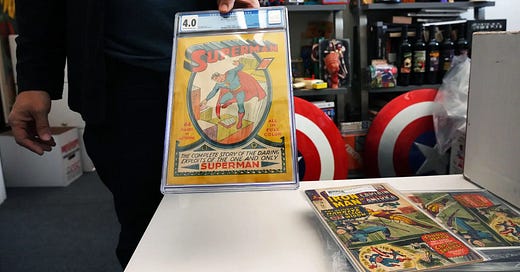Into The Pope-Verse & China’s Young Collectors
The Vatican gets into the metaverse, and young collectors in China are pushing the market forward
Cultured is a newsletter that gets readers up to speed on the most interesting things going on at the intersection of finance, art, collectibles, NFTs, and more. Cultured is produced by Otis, an alternative investment platform that was recently acquired by Public.com.
Love Cultured? Spread the word and share this newsletter with a friend!
🗞 STORIES OF THE DAY
What should we make of the Vatican’s metaverse plans?
Last week, the Vatican (yes, that Vatican) announced it was entering the metaverse…kind of. A project affiliated with the Vatican has teamed up with Sensorium, a major metaverse developer, to create a series of VR and NFT projects.
The project is part of the Humanity 2.0 Foundation, a platform run by Father Philip Larrey, who is the Dean of Philosophy at the Pope's University in Vatican City. The foundation seems to be a vehicle for future-focused public-private partnerships.
The goal of the new metaverse project is to decentralize the Vatican’s art and make it more accessible. The two organizations will also work together on forming an ethical framework for the metaverse.
Our Take: We don’t really get what the Vatican’s metaverse plans are, but it could be transformational.
It seems like Humanity 2.0 doesn’t quite understand what it’s doing in the metaverse yet, either. But it’s clear that the Vatican wants to take on a similar role to what it’s had throughout most of history: a moral guiding force. Whether the Church should be that guide is a separate and highly complicated question, but it’s clear they see an opportunity to assert their power in the metaverse.
The rise of China’s young collectors
A new class of Chinese collectors under 40 are changing the dynamics of the art market, both inside the country and globally. Flush with cash from their parents (or from their own ventures), these young buyers are snapping up everything from watches to skateboards.
Remember that set of 248 Supreme skateboards that sold for $800,000? The buyer was 17-year-old Carson Guo, who bought them on his lunch break in high school. Like his peers, Guo started bidding on smaller items and worked his way up to big purchases.
Younger collectors are also less risk-averse than their older peers, which has helped buoy lesser-known artists like Javier Calleja and Tala Madani.
Our Take: The growth of China’s young collecting class is a product of a booming art market.
The notoriously unstable art market has been on a decade-long boom, meaning that most of these younger collectors have yet to experience a crash. That’s made them much more willing to take risks than their younger peers. When the market does start to sink again, it’ll be interesting to see how their collecting practices change.
✨ AROUND THE INTERNET
Who’s doing NFTs now? Harvey Nichols, Milan’s Ambrosiana Library, and Jacob & Co. (Check out the full list of NFTs by celebs and big brands on Otis Mag).
A vintage Cartier Crash from 1967 sold for $1.65 million at auction, twice the presale estimate. It’s the latest sign that the vintage Cartier market is booming.
Funko, the toymaker best known for those plastic Pop collectible figures, just raised $263 million from a group of entertainment industry investors.
Here’s how Diego Maradona’s $7 million jersey from the 1986 World Cup quarterfinal got to auction.
How Vincent Zurzolo, the owner of Metropolis Collectibles and Comic Connect, spends his Sundays.




